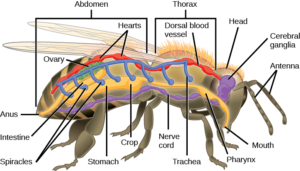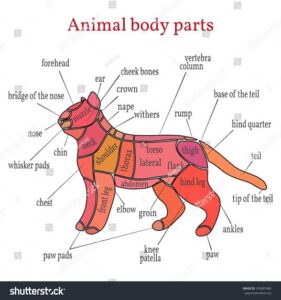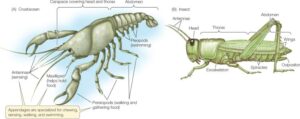Back to: ZOOLOGY 200 Level
WELCOME TO CLASS
Today, we’re focusing on something you can easily spot in many animals—body regions and appendages. These features help animals move, feed, sense their surroundings, and carry out different life processes. Whether it’s the legs of a cockroach or the claws of a crab, every part plays an important role. Let’s look at how these structures are organised and why they matter.
Body Regions And Appendages
Body regions vary by group
Different animals have different body plans. In arthropods like insects, the body is divided into three major regions: head, thorax, and abdomen. Each region has specific roles. The head usually houses the eyes, antennae, and mouthparts. The thorax bears the legs and wings, while the abdomen contains most of the digestive and reproductive organs.

In crustaceans, like crabs and prawns, the body is usually divided into two regions: cephalothorax (a fusion of head and thorax) and abdomen. These structural differences reflect how animals adapt to their environments and lifestyles.
Appendages are modified for specific functions
Appendages are external body parts that stick out from the main body, such as legs, antennae, claws, wings, and mouthparts. These parts are jointed in arthropods, allowing for a wide range of movements.
For instance, a grasshopper has six legs attached to the thorax, helping it to walk and jump. Insects like butterflies use wings for flying. Crabs have powerful pincers (claws) used for defence and feeding. Antennae help animals sense their environment by detecting touch, sound, or smell.

Diversity of appendages shows adaptation
The type, number, and arrangement of appendages differ from one group of animals to another. Insects usually have three pairs of legs and two pairs of wings. Spiders, which are arachnids, have four pairs of legs and no wings. Millipedes and centipedes have many legs, adapted to crawling through narrow underground spaces. These variations show how body parts evolve to fit different ways of living.

Summary
- Most arthropods have bodies divided into regions such as head, thorax, and abdomen, or cephalothorax and abdomen.
- Appendages include legs, wings, antennae, and claws, all adapted for tasks like movement, feeding, and sensing the environment.
- The number and type of appendages vary widely across different animal groups.
- Body regions and appendages reflect how animals are built to survive and function in their unique habitats.
Evaluation
- Name the three main body regions of an insect.
- What is the function of antennae in arthropods?
- Compare the body regions of insects and crustaceans.
- List three types of appendages and their functions.
Every lesson gives you more tools to understand the animal world around you. Keep up the good work, and remember—Afrilearn is right here with you, cheering you on. Shall we move to the next exciting topic?
